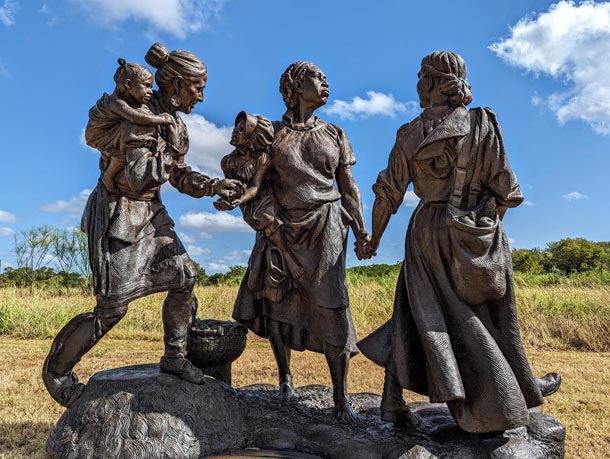The Women’s History Trail commissioned nationally renowned figurative sculptor Wesley Wofford to produce a 7-foot-high bronze sculpture of three women whose lives and cultures intersected in the early days of Macon County.
The hands of the women are all touching, illustrating the ideal of a sisterhood of women that can help bridge the cultural divides present both then and now.
The sculpture, “Sowing the Seeds of the Future,” tells the story of Na-Ka Rebecca Morris, a Cherokee woman; Salley, an enslaved woman; and Harriet Timoxena Siler, a pioneer woman. Each is connected by a property that was on the Little Tennessee River across from the Noquisiyi (or the Nikwasi) Mound.
In the sculpture, Na-Ka Rebecca Morris is seen passing corn seeds to a young girl. Her child is on her back, secured by a traditional wrap. She is looking to the future, toward the long and harrowing journey of her descendants to re-establish the modern-day Cherokee Nation.
The Cherokee for generations used Noquisiyi Mound and the surrounding land to celebrate the annual Green Corn Festival. Na-ka Rebecca is standing on a mound, which honors the Noquisiyi site and represents the foundation on which the entire town of Franklin was built. She is elevated in comparison to the other women, a reference to women being the landowners in Cherokee society.
Na-ka Rebecca was a Cherokee woman born in Noquisiyi in 1792, daughter of Nancy whose brother was the well-known chief, Yonaguska. She married Gideon Morris, a farmer and Baptist preacher from South Carolina.
In 1819 they obtained a 640-acre reserve on the east side of the Little Tennessee River, across from the Noquisiyi Mound, in what is now East Franklin. Just a year later, they were burned out of their home and forced to give up their land. They moved to downtown Franklin, where…
Read the full article here



